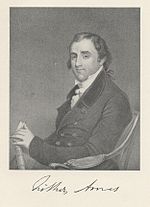Jason Fairbanks
This article has multiple issues. Please help improve it or discuss these issues on the talk page. (Learn how and when to remove these messages)
|
Jason Fairbanks | |
|---|---|
| Born | September 25, 1780 |
| Died | September 10, 1801 (aged 20) |
| Criminal status | Deceased |
| Conviction(s) | Murder |
| Criminal penalty | Death by hanging |
| Part of a series on the |
| History of Dedham |
|---|
 |
| Main article |
| Dedham, Massachusetts |
| By year |
| By topic |
Jason Fairbanks (September 25, 1780 – September 10, 1801) was an American murderer. Fairbanks came from a prominent family in Dedham, Massachusetts. He was the son of Ebenezer and Prudence Farrington Fairbanks and lived in the Fairbanks House, today the oldest wood-framed house in the country. He was born with a lame arm. His sixth cousin, once removed, was Vice President Charles Fairbanks.
History
Fairbanks had been courting Elizabeth Fales, the daughter of Nehemiah Fales, although she was resistant to marrying him. Finally on May 18, 1801, Fairbanks was determined to force her to make up her mind. He met with Fales in a birch grove next to "Mason's pasture" in Dedham, though the exact location today is not known.
Later, Fairbanks appeared at the Fales house, covered with blood and holding a knife. He told them that their daughter had committed suicide and he had tried to do the same but could not. She had been stabbed 11 times, including once in the back.
Fairbanks' wounds were serious; he was in no shape to be taken directly to jail. He was therefore taken into the Fales household, where he received medical treatment. On August 8, 1801, after a three-day trial and Elizabeth Fales' funeral on May 20, a jury indicted Fairbanks as an accessory to her death and he was jailed.
James Sullivan, the Attorney General of Massachusetts, handled the prosecution. Harrison Gray Otis and John Lowell, Jr., two prominent Federalist lawyers, defended Fairbanks. He was found guilty of the murder and was sentenced to death by hanging.
Escape
Before the execution could take place, Fairbanks escaped with the help of his brother, a cousin, a friend, and his nephew, Nathaniel Davis. A $1,000 bounty was placed on his head, and a newspaper headline screamed "Stop the Murderer!" The party tried to make their way to Canada, but stopped to eat in Skenesboro, now known as Whitehall, New York, just south of the Canada–US border. Fairbanks was recaptured.
Fairbanks was returned to the Boston jail, for authorities no longer trusted the Dedham jail, and on September 10, 1801, Fairbanks was hanged at a massive event. He was twenty years old. Two Army cavalry companies and a volunteer militia unit made sure he did not escape again, and the 10,000 people who showed up at the Town Common to witness the execution were five times the town’s population at the time.
Within two days of his execution, the Report of the Trial of Jason Fairbanks was published. The story was then written up in a pamphlet entitled A Deed of Horror! Trial of Jason Fairbanks for the Murder of His Sweetheart in 1801. It became the basis for a novel called The Life of Jason Fairbanks: A Novel Founded on Fact, which is believed to no longer exist.
General references
- Freeman, Dale H. Melancholy Catastrophe! The story of Jason Fairbanks and Elizabeth Fales, Historical Journal of Massachusetts, Winter 1998.
External links
- 1780 births
- 1801 deaths
- 1801 crimes
- American people convicted of murder
- People executed for murder
- 19th-century executions by the United States
- People from Dedham, Massachusetts
- People executed by Massachusetts by hanging
- Executed people from Massachusetts
- People convicted of murder by Massachusetts
- 19th-century executions of American people
